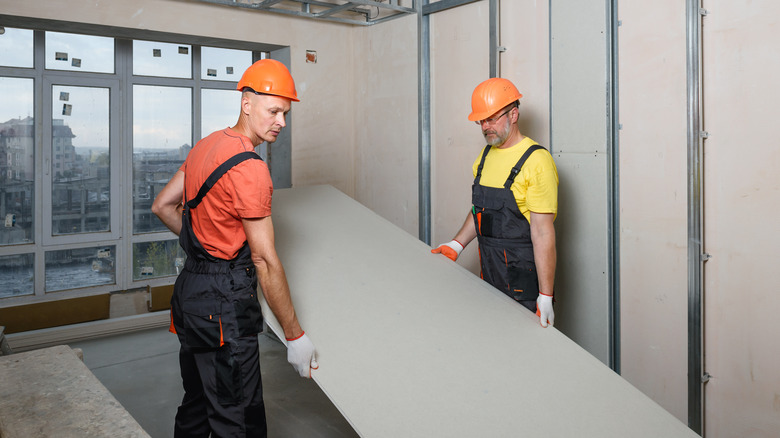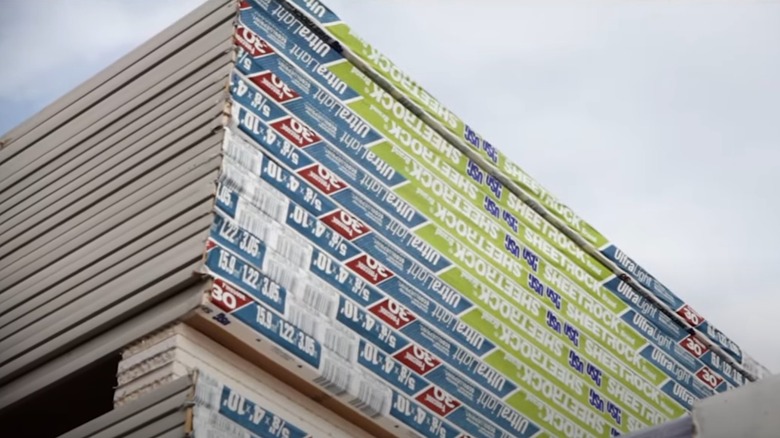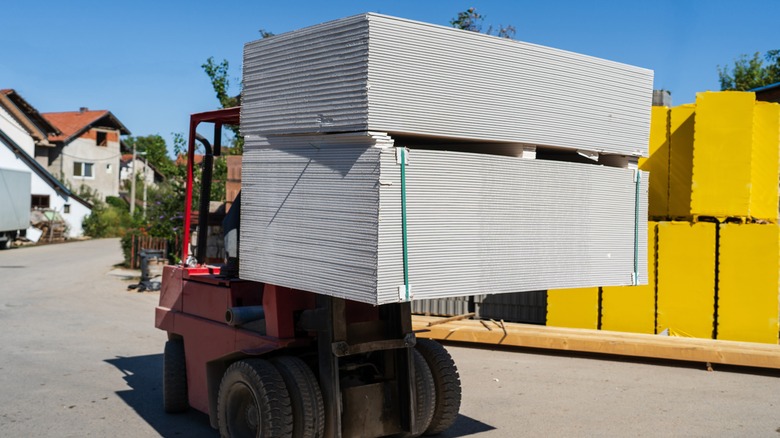Our Construction Expert Explains If There Is A Difference Between Drywall And Sheetrock
One of the most important jobs in home construction and home repair — and one that also sparks quite a bit of uncertainty among DIYers — is drywall installation. Some people have confidence that they can jump in and do this job themselves, believing they know everything needed to hang drywall like a pro. Other homeowners want no part of this kind of DIY job because removing drywall without making a mess is incredibly difficult and because the pros are so efficient that it can be tough to justify doing it yourself.
Not only do the pros have all the tools and experience with this material, but they also understand all the different kinds of products that people collectively describe with the term "drywall." You may hear terms like "wallboard," "plasterboard," "gypsum board," "purple board," and "green board" used to describe this material. One of the most popular terms is "Sheetrock."
Even though drywall pros know key information, like where to use green board drywall and the difference between drywall and Sheetrock, you might not. You also may not know which circumstances, if any, are best to use one over the other. We decided to reach out to an expert to learn the difference, and Jason Pietruszka, founder of JJP Construction and a real estate developer, gave us the scoop. "They are all the same material," he tells House Digest in an exclusive interview. "Some are thicker, thinner, heavier, [or] lighter."
What exactly is Sheetrock?
When you go to the hardware store to order some drywall for your project, you may wonder whether you should order drywall or Sheetrock. As Pietruszka exclusively tells House Digest, you don't have to sweat this decision because they're basically the same product. "Sheetrock is easily explained," he says. "Sheetrock is actually one brand of drywall, and it's made by the U.S. Gypsum Company (USG). It was created in the early 1900s, so it's become synonymous with the word drywall. Drywall is also called wallboard, gypsum board or plasterboard." Think of it like the brand name Kleenex becoming synonymous with facial tissues for many people.
How do you know if you have Sheetrock or another type of drywall? Look at the edge of the sheet, which should have printed paper covering it. (A thin layer of paper wraps the entire panel, but the printing is only on the edge.) If it's Sheetrock, the printed paper will contain the Sheetrock brand name as well as the USG logo. It should also list the dimensions of the sheet, usually 4 feet by 8 feet by 1/2 inch. Other brands of drywall will also have their names printed on the edges of the panels.
Differences between Sheetrock and other drywall brands
Perhaps the best way to think about drywall versus Sheetrock is that all Sheetrock is drywall, but the reverse is not true. Multiple other brands of drywall are available for purchase, even though Sheetrock is almost certainly the best known. Many people consider Sheetrock to be one of the better brands of drywall. Other brands include ToughRock, CertainTeed, and Gold Bond.
When it comes to choosing the brand you want to use, Pietruszka says the differences are minimal for the majority of people doing DIY work. "There are different types of drywall boards, [but] like I said, they are mostly all the same," he tells House Digest in an exclusive interview. He says his favorite drywall is a configuration that weighs less, as lightweight drywall is easier to lift into place and install.
Carrying these sheets into the room where you'll hang them is far easier with lightweight models, too. A standard sheet may weigh about 60 pounds, but a lightweight sheet could weigh about 41 pounds. If you're carrying dozens of sheets per day, the weight difference adds up quickly. USG touts the fact that its configuration of lightweight Sheetrock makes its sheets up to 30% lighter than standard sheets. Pietruszka says, "The lighter, the better!"


